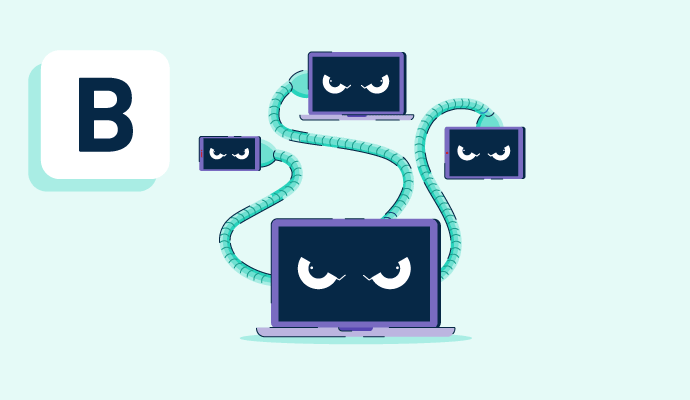What is a botnet?
A botnet is a cluster of interconnected devices under a single master computer’s control. These devices include computers, internet of things (IoT) devices, and smartphones.
Botnets often have malicious intent. They use the collective computational power of devices in their network to launch a distributed denial of service (DDoS) against a target. Many organizations use DDoS protection software to protect against such attacks while ensuring consistent uptime.
Types of botnet attacks
Botnets are of two types, centralized and decentralized. The centralized botnets follow a command and control (C&C) server model. Simply put, one centralized server commands all devices in a botnet. Decentralized botnets work on a peer-to-peer (P2P) model, with every bot acting as a command center and an attack node.
These two botnet types converge various types of attacks on businesses and individuals.
- Brute force attacks involve a hacker trying all possible combinations of letters and numbers until they crack the password. Botnets allow every computer to try as much as possible until it is locked out. With the number of systems trying, the possibility of cracking the password increases.
- Wide-spread spam attacks spread malware faster through botnets in phishing attacks. Botnets help spread spam faster, hitting as many people as possible.
- DDoS attacks aim at exhausting a user’s resources to create a denial of service situation. Botnets help in DDos attacks as it reaches a lot of systems at the same time. Most DDoS attacks are aimed at causing downtime to the target systems.
- Generating fake traffic is possible with botnets. Threat actors to attract unethical gains based on website visits.
Architecture of a botnet
A botnet’s architecture depends on its types. A centralized server botnet uses a client-server model, and the decentralized botnet leverages the P2P model.
- The client-server model is one where all the connected devices receive instructions from a single location. One device controls the server and communicates with other interconnected devices, which are its clients. Security teams can target the central server bot to disarm an entire botnet as other devices are connected to the former.
- The P2P model relies on an advanced architecture and is far more secure than the client-server model. Each bot acts as a client and server in this model.
How to prevent botnet attacks
Explore the ways below to protect against botnet attacks. Remember, they’re not simple malware and can be extremely dangerous for organizations.
- Keep the operating system (OS) updated. An outdated OS may have loose ends that allow hackers to launch botnets. An updated OS safeguards a system from botnets and other threatening malware.
- Update all installed applications. An outdated application is an accessible invitation for botnets to launch. Constantly update to the latest version of the installed software to protect against botnet attacks.
- Don’t open suspicious emails. Email is one of the common malware carriers. Adopt an email security solution to thoroughly scan emails, especially those with attachments. Look out for the source of the email; if it seems suspicious, avoid opening or downloading the attachment.
- Avoid downloading from unreliable sources. Hackers select a platform with a maximum user base to launch malware. It’s a healthy practice not to download freeware from unknown or insecure websites. The possibility of one or more of those freeware containing malware is very high.
- Use strong and unique passwords. Employing unique and robust passwords for every online account prevents botnets from gaining access.
- Avoid clicking suspicious links. Like emails and freeware, infected links are also common malware carriers. One such example is the trojan horse. Most infected links are spread through social network platforms. Never click on unknown links or pop-ups to keep the system secure.
- Get antivirus software. Adopt antivirus software to detect and eliminate any potential malicious threat from botnets or other cyber attacks.
Botnet vs. worm
A botnet is a group of interconnected devices infected by malware that communicate and coordinate with each other to disrupt a target network or a system. The term botnet is a mix of network and robot. It fuels cybercrimes by leveraging the collective computational power of interconnected systems.
On the other hand, a worm is a kind of malware that can replicate rapidly and spread across devices. It consumes bandwidth as it spreads, making the infected system unreliable and unavailable. Worms can also change or delete files or also bring in other malware. They’re standalone software and do not need a host program to disrupt IT operations and cause data loss.
While a worm can be part of a botnet and used to spread the botnet's malware, not all worms are part of botnets, and not all botnets use worms. Each has unique traits and purposes, and the prevention methods differ accordingly.
Learn more about intrusion detection and prevention systems (IDPS) to safeguard devices and networks against cyber attacks.

Sagar Joshi
Sagar Joshi is a former content marketing specialist at G2 in India. He is an engineer with a keen interest in data analytics and cybersecurity. He writes about topics related to them. You can find him reading books, learning a new language, or playing pool in his free time.
